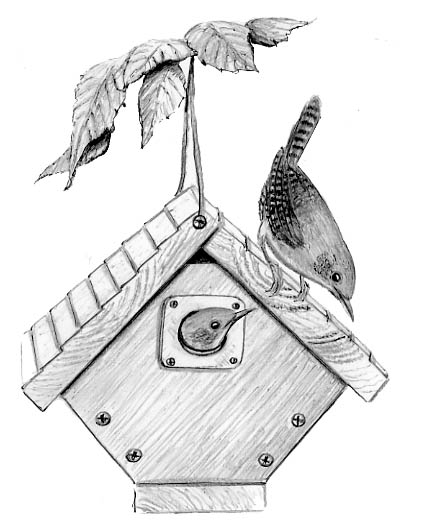
Dear Bird Folks,
I have a couple of birdhouses that I haven’t gotten around to putting up yet and now a friend tells me that it is too late to put them out. It’s only mid-June and the good weather hasn’t even hit yet. Is it really too late for me to put out my birdhouses?
– Denny, -Ho-Ho-Kus, NJ
Me too, Denny,
I have a friend like that too. For years my friend has been yapping at me that when June rolls around, birds lose their interest in nesting and birdhouses occupancy is over until next year. I don’t know anything about your friend, Denny, but my friend is a well-respected naturalist and is extremely knowledgeable about all aspects of nature, including birds. However (and you knew this “however” was coming), my friend, just like yours, is way off on this birdhouse thing. I don’t know what their problem is. Perhaps they both cut class the day Professor Procreate gave his famous, and very accurate, “There’s never a bad time to put out a birdhouse” lecture. Too bad they missed it. It was a great lecture. Although, it wasn’t as good as the day Professor Baffle gave his “No squirrel shall pass” lecture, but it was close.
Though it varies from species to species, most migrating songbirds only have a single brood. For them it’s one and done. After the long migration they don’t have the energy to crank out more than one family. And don’t forget, their time here is short. Most migrating birds arrive from Central and South America, which means they are subject to the restrictions set by the U.S. Government’s controversial “Guest Breeder Program.” The birds have only a few weeks to lay their eggs, raise their baby birds, and get out before they have winter and an INS agents knocking on their nests.
Other birds, perhaps because their migration is shorter or because they have the proper paperwork, aren’t in such a hurry to get in and get out. They stay for a second or perhaps a third brood. And some of these extra breeding birds use our birdhouses. The most notable bird to have a second brood is the bird that probably started us humans building birdhouses in the first place. It’s our old pal, the House Wren.
It should come as no surprise to anyone that House Wrens have a second brood. These ridiculously energetic birds, which start each day with a can of Red Bull and a gallon of Jolt Cola, need to be doing something every minute of the day. As soon as the male reaches his breeding grounds he stakes out his territory by filling every nesting cavity he can find with sticks and twigs. When the female arrives, she immediately inspects all the sites and quickly settles on one that suits her needs. She then builds the nest, lays the eggs and tends the babies. Typically, the male wren assists the female by providing food so she may remain with the chicks.
Sometimes, however, caring for a growing family isn’t enough to keep the ADD-riddled male occupied. Some male wrens leave their original family and begin a brand new family with a nearby unmated female. This, of course, creates a need for a late season nest box. That’s right, the new couple will be looking for a new nest box. And even if the male has his ADD under control and remains with the same family until the babies have all fledged, House Wrens almost always have a second brood, which once again means they may need a new nest box.
The other birdhouse nester that often has a second brood is the bird that many people can get enough of, the Eastern Bluebird. Bluebirds are at the opposite end of the energy scale from the House Wren. Where as wrens seem as if they are moments away from having a massive stroke, bluebirds are the definition of laid back. But don’t let the bluebird’s laid-back attitude fool you. They are ready to “get busy” the moment the opportunity presents itself. As soon as the first brood of baby bluebirds has fledged, the parents start working on the next batch. Sometimes they use the same box, but sometimes they are in the market for a new one. Yes, a new one, even if it’s past the middle of June.
Both House Wrens and bluebirds may be looking for nest sites well into July. Any birdhouses put out by then have a chance of being used. In addition, many other cavity nesters – chickadees, titmice, Tree Swallows, etc. – may also be looking for a nest box late in the season if their original nesting attempt failed due to weather or predation.
Yes, Denny, put your birdhouses out. There’s a decent chance that they will be used this year. Even if they aren’t used, perhaps the birds will remember their location come next spring. And don’t forget about winter. Many birds use birdhouses in the off-season to get away from the cold. Remember, “there’s never a bad time to put out a birdhouse.” Professor Procreate would be so proud of me.